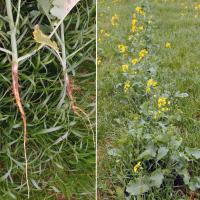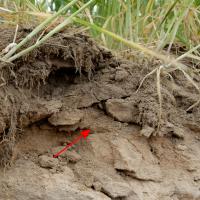Diagnosing sandplain traffic pan
Sandy soils, particularly loamy sands with less than 20% gravel that are deeper than 25 centimetres (cm) are very susceptible to subsoil compaction from agricultural traffic.
Economic response depends largely on the potential yield for the soil, with best results on yellow loamy sandplain in the >350 millimetres (mm) rainfall area. Increased early plant growth uses more soil water, leaving less for later grain production in seasons with a dry spring.
What to look for
- Greener more vigourous plants in ripped or cultivated areas on sandy soils.
- Poorer plants and delayed flowering in linear zones matching the paths of heavy cropping gear, such as seeder air carts and harvesters.
- Sandy subsoil may appear normal, but is more dense.
- Dense subsoil often occurs as a compact band up to 25cm thick.
- The depth to the band varies from about 20cm (loamy sand) to 40cm (coarse sand).
Paddock
- Less vigourous often nitrogen deficient plants.
- Cereal roots may be visibly thickened and compressed below about 20cm depth.
- Canola taproots are shallower, less vigourous and may grow sideways along the top of the compacted layer.
Plant
What else could it be
| Condition | Similarities | Differences |
|---|---|---|
| Diagnosing nitrogen deficiency in wheat | Same above ground symptoms | Easily distinguished by the testing the soil for a traffic pan |
Where did it come from?
- Traffic on moist soil by farm vehicles and repeated cultivation forces soil particles and aggregates together, increasing soil strength.
- Loamy or clay sands compact more easily than sands with little clay.
- Vehicle weight and axle loads are the most important factors influencing the formation of sandplain traffic pans. Vehicle loads of 10 tonnes (t) can result in subsurface compaction to 50cm.
- Roots slowed by compaction are less effective at keeping up with water and dissolved nutrients, particularly nitrogen, as they infiltrate through the soil profile.
Management strategies

Cultivation
- Deep ripping moist soil.
- Spading and mouldboard ploughing (may be less effective than deep ripping).
- Deep working at seeding. Yield response of 32-50 kilograms per hectare (kg/ha) for each centimetre of extra soil ripped may be expected in sandy earths in a reasonable season in the medium rainfall area.
- Minimise recompaction through:
- Controlled traffic farming (confining compaction to specific zones).
- Operating machinery at correct tyre pressures.
- Reducing axle loads to less than 10t.
- Increasing vehicle flotation.
- Yield responses to deep cultivation have been greatest on sandy earth soils where there is sufficient rainfall for the crop to maximise the benefit of additional nitrogen available to the plant from ripping.
- Less or no yield response occurs in the following situations: Dry finish to the season; Reduced yields may result from ripping in these situations as the plants use more water during early growth; Where there is clay or (more than 20% gravel) within 30cm of the soil surface; Where there is hostile subsoil (such as soil acidity) that restricts root penetration; In sands with poor water holding capacity; Insufficient depth of ripping (very heavy loaded wheels and tracks can have peak strengths at 50-60cm in sands.
How can it be monitored?
- The compacted layer cannot be seen but can be determined in sands by measuring soil resistance using a penetrometer. An indication of a compaction layer also is possible by pushing a 5mm metal rod into the soil.
- Check there is no gravel or clay in the top 30-40cm of soil. The soil must be moist to that depth.
- It will be harder to push the probe into the compaction layer, but get easier again as the probe moves through the layer.
- The depth of the compaction layer varies according to soil type - the lower the clay content of the soil, the deeper the hard layer. On loamy sands and yellow earth (as at Wongan Hills) with 10-12% or more clay, the compaction layer has maximum strength at about 20cm depth. Yellow sands and earthy sands, such as Eradu sandplain, have 4-8% clay and the hard pan is at about 25cm. Deep white sands with little clay have a pan at 30cm or more.
See also
Page last updated: Wednesday, 28 February 2018 - 9:56am





